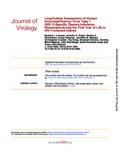| dc.description.abstract | Human immunodeficiency virus type 1 (HIV-1) infection results in different patterns of viral replication in pediatric compared to adult populations. The role of early HIV-1-specific responses in viral control has not been well defined, because most studies of HIV-1-infected infants have been retrospective or cross-sectional. We evaluated the association between HIV-1-specific gamma interferon (IFN-gamma) release from the cells of infants of 1 to 3 months of age and peak viral loads and mortality in the first year of life among 61 Kenyan HIV-1-infected infants. At 1 month, responses were detected in 7/12 (58%) and 6/21 (29%) of infants infected in utero and peripartum, respectively (P = 0.09), and in approximately 50% of infants thereafter. Peaks of HIV-specific spot-forming units (SFU) increased significantly with age in all infants, from 251/10(6) peripheral blood mononuclear cells (PBMC) at 1 month of age to 501/10(6) PBMC at 12 months of age (P = 0.03), although when limited to infants who survived to 1 year, the increase in peak HIV-specific SFU was no longer significant (P = 0.18). Over the first year of life, infants with IFN-gamma responses at 1 month had peak plasma viral loads, rates of decline of viral load, and mortality risk similar to those of infants who lacked responses at 1 month. The strength and breadth of IFN-gamma responses at 1 month were not significantly associated with viral containment or mortality. These results suggest that, in contrast to HIV-1-infected adults, in whom strong cytotoxic T lymphocyte responses in primary infection are associated with reductions in viremia, HIV-1-infected neonates generate HIV-1-specific CD8+-T-cell responses early in life that are not clearly associated with improved clinical outcomes. | en |

